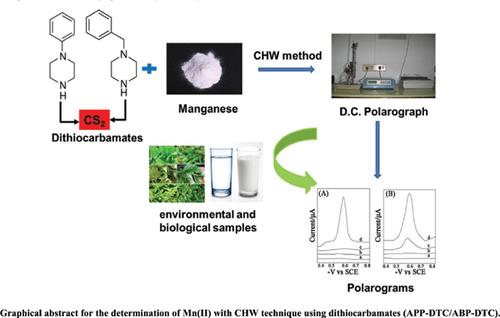Current Analytical Chemistry ( IF 1.8 ) Pub Date : 2021-05-31 , DOI: 10.2174/1573411016666200116093214 Niranjan Thondavada 1 , Rajasekhar Chokkareddy 1 , Gan G Redhi 1 , Venkatasubba Naidu Nuthalapati 2

|
Background: A simple, low cost and highly sensitive catalytic hydrogen wave (CHW) method has developed for the investigation of Manganese(II) in ammonium 4-phenylpiperazine-1- dithiocarbamate and ammonium 4-benzylpiperidine-1-dithiocarbamate in various environmental and biological samples using D.C. polarography. This procedure was based on the reaction of Mn(II) in APP-DTC/ABP-DTC in the presences of NH4Cl-NH4OH medium at pH 6.6 and 7.2 respectively. The resulting oxidation signals were obtained at -0.78 V and -0.64 V vs SCE, owing to the CHWs. Different experimental conditions such as pH effects, background electrolyte (NH4Cl-NH4OH) effects and DTCs and Mn(II) ion effects have been studied. The current method was effectively employed for the testing of Mn(II) in different environmental and biological samples and attained recovery percentages (95-99%) are comparable to the Atomic Absorption Spectrophotometry (AAS) method.
Methods: Direct current polarography, model CL-357 and CL-25 (Elico Private Ltd, Hyderabad, India), Shimadzu AA 6300 spectrometer furnished thru a deuterium background corrector and hollow cathode lamp, at corresponding wavelengths (resonance line) with an air acetylene flame. The experimental guidelines remained those suggested by the makers.
Results: The effect of NH4Cl between 0.1 to 0.7 M on the nature of CHW at DME, maintaining the concentrations of Mn(II) at 4.0 ppm and DTC at 3.0 mM (APP-DTC/ABP-DTC) then adjusting the pH to 6.6/7.2 (APP-DTC/ABP-DTC). The polarograms were well-defined in NH4Cl of 0.4/0.5 M for APP-DTC/ABP-DTC. The peak height decreased beyond this concentration and therefore 0.4/0.5 M (APP-DTC/ABP-DTC) concentrations was kept for more analysis. At fixed concentration of DTC, (3.0 mM APP-DTC/ABP-DTC) and (0.4/0.5 M for APP-DTC/ ABP-DTC) NH4Cl adjusting the pH to 6.6/7.2 respectively the metal ion concentration of the Mn(II) was adjusted between 0.05 to 7.0 ppm and results of CHWs were studied. The peak current increased linearly with Mn(II) concentration in the range 0.05 to 4.0 ppm for both DTCs. However, the sensitivity of the method was more with APP-DTC/ABP-DTC because of strong complex of Mn(II) and increased catalytic activity.
Conclusion: The developed CHW method is highly sensitive, simple and spontaneous for the analysis of Mn(II) in environmental and biological samples. The polarographic reduction of Mn(II) in aqueous solutions in the attendance of DTC displays a catalytic wave as a role of pH, concentration of supporting electrolyte and metal ion. The graphs of catalytic signals as a role of the concentration of dithiocarbamate shows that the signals do not vary linearly with the concentration of dithiocarbamate which the characteristic of Brdicka CHWs. It is presumed that the dithiocarbamate complexes with metal ions involve adsorption process and can be described by a Langmuir adsorption isotherm and the plot of CL/ip Vs CL should be linear. The CHW method is free from interference effect avoiding the removal stages which made towards placing among utmost sensitive methods for the analysis of Mn(II) in different Environmental and Biological samples.
中文翻译:

催化氢波(CHW)技术测定环境和生物样品中的锰(II)
背景:开发了一种简单,低成本,高灵敏度的催化氢波(CHW)方法,用于研究各种环境和生物中4-苯基哌嗪-1-二硫代氨基甲酸铵和4-苄基哌啶-1-二硫代氨基甲酸铵中的锰(II)。样品使用直流极谱法。该程序基于Mn(II)在APP-DTC / ABP-DTC中分别在pH 6.6和7.2的NH 4 Cl-NH 4 OH介质中的反应。由于CHW,在相对于SCE的-0.78 V和-0.64 V下获得了氧化信号。不同的实验条件,例如pH值影响,背景电解质(NH 4 Cl-NH 4OH)效应以及DTC和Mn(II)离子效应已得到研究。目前的方法有效地用于测试不同环境和生物样品中的Mn(II),并且达到的回收率(95-99%)与原子吸收分光光度法(AAS)相当。
方法:型号为CL-357和CL-25(印度海得拉巴的Elico Private Ltd)的直流极谱仪,Shimadzu AA 6300光谱仪,通过氘背景校正器和空心阴极灯在相应的波长(共振线)处配有空气乙炔。火焰。实验准则仍然是制造商建议的准则。
结果:0.1-0.7 M的NH4Cl对DME的CHW性质的影响,将Mn(II)的浓度保持在4.0 ppm,将DTC的浓度保持在3.0 mM(APP-DTC / ABP-DTC),然后将pH值调节到6.6 /7.2(APP-DTC / ABP-DTC)。对于APP-DTC / ABP-DTC ,极谱图在0.4 / 0.5 M的NH 4 Cl中得到了很好的定义。峰高下降到超过此浓度,因此保留0.4 / 0.5 M(APP-DTC / ABP-DTC)浓度以进行更多分析。在DTC的固定浓度下,(3.0 mM APP-DTC / ABP-DTC)和(0.4 / 0.5 M对于APP-DTC / ABP-DTC)NH 4Cl分别将pH调节至6.6 / 7.2,将Mn(II)的金属离子浓度调节在0.05至7.0 ppm之间,并研究了CHW的结果。两种DTC的峰值电流均随Mn(II)浓度在0.05至4.0 ppm范围内线性增加。但是,由于Mn(II)的强络合物和增加的催化活性,使用APP-DTC / ABP-DTC的方法灵敏度更高。
结论:所开发的CHW方法对环境和生物样品中的Mn(II)的分析具有很高的灵敏度,简便性和自发性。在DTC的作用下,水溶液中Mn(II)的极谱还原显示出催化波,其作用是pH值,支持电解质的浓度和金属离子的作用。催化信号与二硫代氨基甲酸酯浓度的关系曲线图表明,信号与Brdicka CHWs的特征特征的二硫代氨基甲酸酯浓度没有线性变化。据推测,二硫代氨基甲酸酯与金属离子的络合物涉及吸附过程,可以用Langmuir吸附等温线描述,CL / ip Vs CL的图应为线性。



























 京公网安备 11010802027423号
京公网安备 11010802027423号